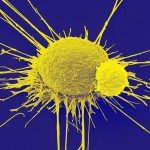Link to Pubmed [PMID] – 25941228
Antimicrob. Agents Chemother. 2015 Jul;59(7):4206-14
Plasmodium falciparum is transmitted from humans to Anopheles mosquito vectors via the sexual erythrocytic forms termed gametocytes. Erythrocyte filtration through microsphere layers (microsphiltration) had shown that circulating gametocytes are deformable. Compounds reducing gametocyte deformability would induce their splenic clearance, thus removing them from the blood circulation and blocking malaria transmission. The hand-made, single-sample prototype for microsphiltration was miniaturized to a 96-well microtiter plate format, and gametocyte retention in the microsphere filters was quantified by high-content imaging. The stiffening activity of 40 pharmacological compounds was assessed in microtiter plates, using a small molecule (calyculin) as a positive control. The stiffening activity of calyculin was assessed in spleen-mimetic microfluidic chips and in macrophage-depleted mice. Marked mechanical retention (80% to 90%) of mature gametocytes was obtained in microplates following exposure to calyculin at concentrations with no effect on parasite viability. Of the 40 compounds tested, including 20 antimalarials, only 5 endoperoxides significantly increased gametocyte retention (1.5- to 2.5-fold; 24 h of exposure at 1 μM). Mature gametocytes exposed to calyculin accumulated in microfluidic chips and were cleared from the circulation of macrophage-depleted mice as rapidly as heat-stiffened erythrocytes, thus confirming results obtained using the microsphiltration assay. An automated miniaturized approach to select compounds for their gametocyte-stiffening effect has been established. Stiffening induces gametocyte clearance both in vitro and in vivo. Based on physiologically validated tools, this screening cascade can identify novel compounds and uncover new targets to block malaria transmission. Innovative applications in hematology are also envisioned.

